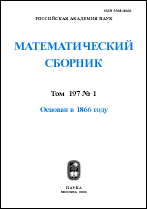|
This article is cited in 9 scientific papers (total in 9 papers)
Framed Morse functions on surfaces
E. A. Kudryavtseva, D. A. Permyakov
M. V. Lomonosov Moscow State University, Faculty of Mechanics and Mathematics
Abstract:
Let $M$ be a smooth, compact, not necessarily orientable surface with (maybe empty) boundary, and let $F$ be the space of Morse functions on $M$ that are constant on each component of the boundary and have no critical points at the boundary. The notion of framing is defined for a Morse function $f\in F$. In the case of an orientable surface $M$ this is a closed 1-form $\alpha$ on $M$ with punctures at the critical points of local minimum and maximum of $f$ such that in a neighbourhood of each critical point the pair $(f,\alpha)$ has a canonical form in a suitable local coordinate chart and the 2-form $df\wedge\alpha$ does not vanish on $M$ punctured at the critical points and defines there a positive orientation. Each Morse function on $M$ is shown to have a framing, and the space $F$ endowed with the $C^\infty$-topology is homotopy equivalent
to the space $\mathbb F$ of framed Morse functions. The results obtained make it possible to reduce the problem of describing the homotopy type of $F$ to the simpler problem of finding the homotopy type of $\mathbb F$. As a solution of the latter, an analogue of the parametric $h$-principle is stated for the space $\mathbb F$.
Bibliography: 41 titles.
Keywords:
Morse functions, framed Morse functions, equivalence of functions, compact surface, $C^\infty$-topology.
Received: 18.03.2009 and 02.07.2009
Citation:
E. A. Kudryavtseva, D. A. Permyakov, “Framed Morse functions on surfaces”, Sb. Math., 201:4 (2010), 501–567
Linking options:
https://www.mathnet.ru/eng/sm7557https://doi.org/10.1070/SM2010v201n04ABEH004081 https://www.mathnet.ru/eng/sm/v201/i4/p33
|


|




 Contact us:
Contact us: Terms of Use
Terms of Use
 Registration to the website
Registration to the website Logotypes
Logotypes








 Citation in format
Citation in format 
